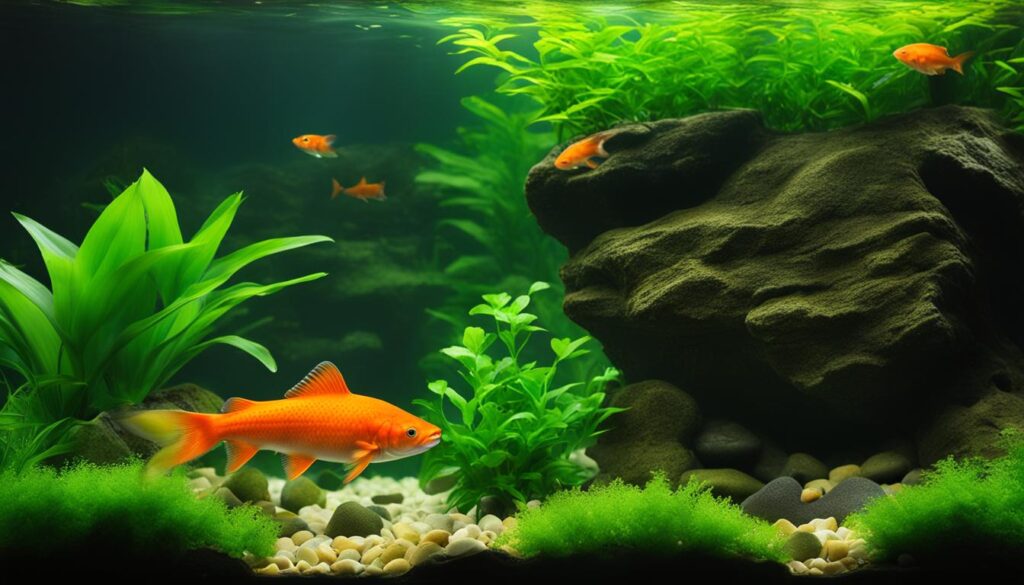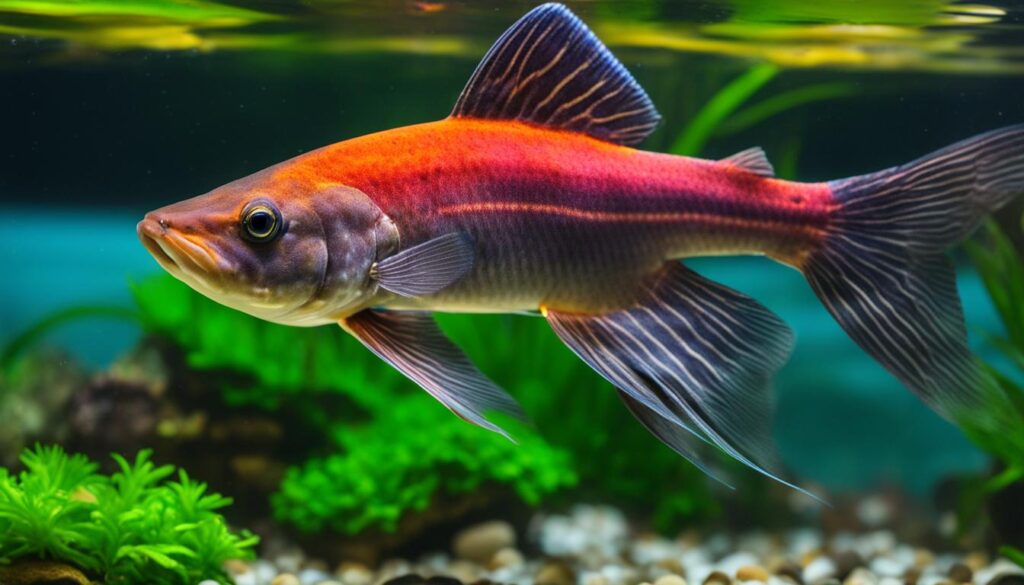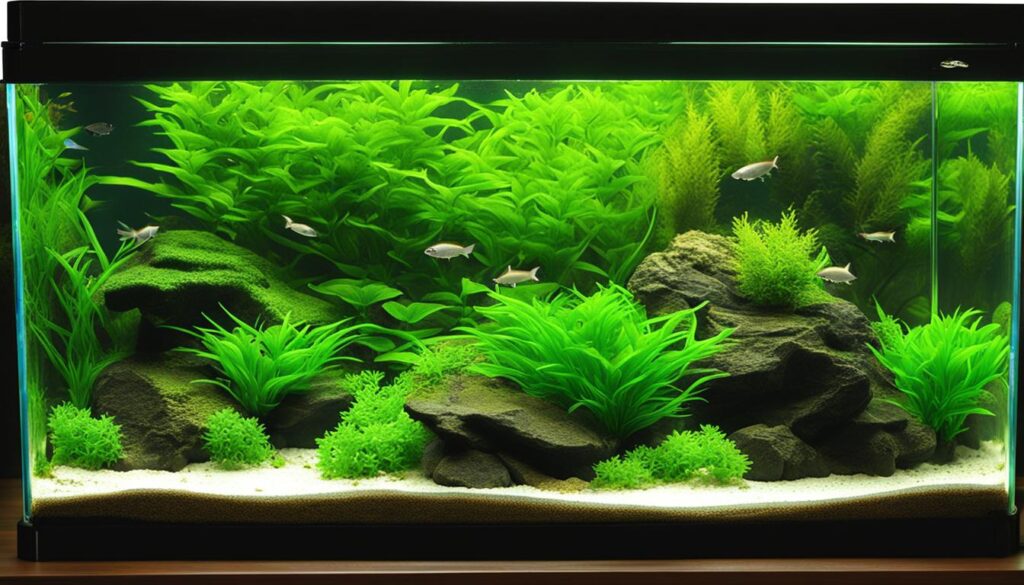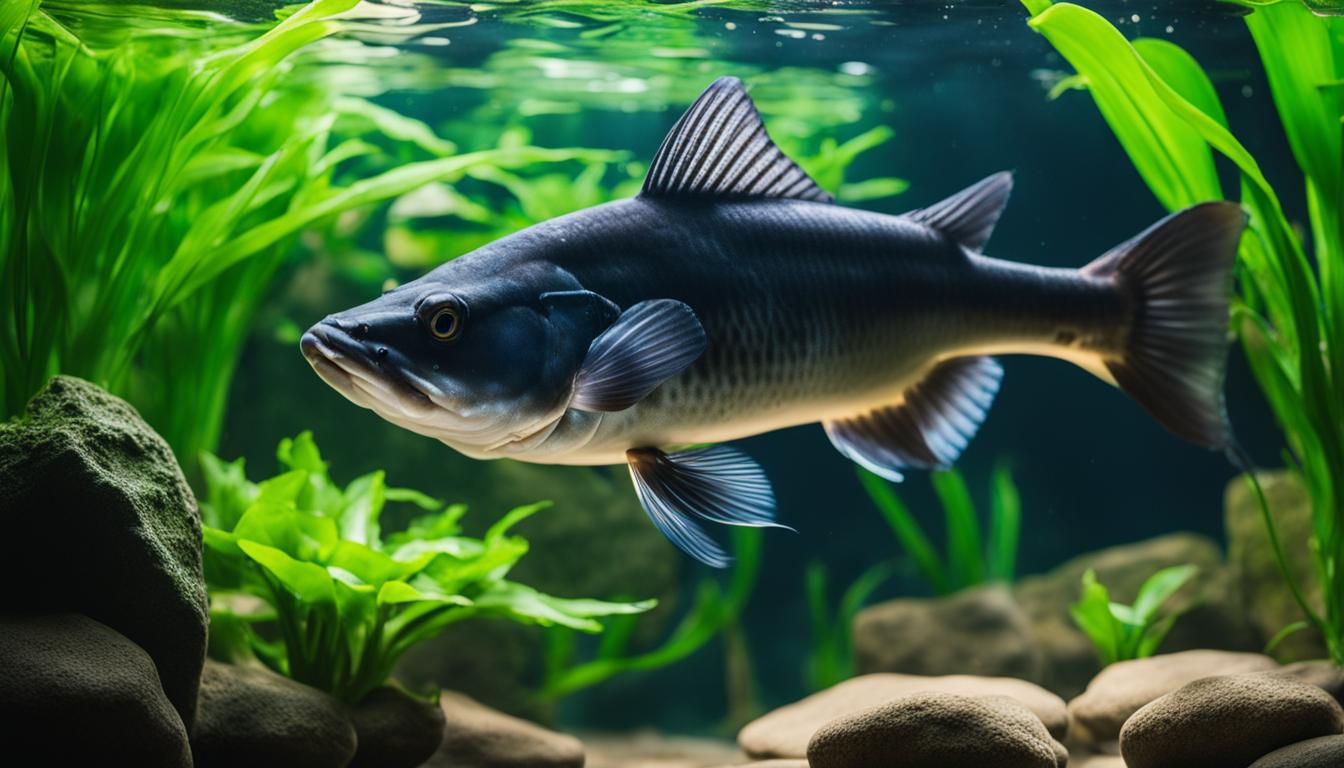As a passionate fish owner, I understand the importance of providing the best possible care for your aquatic pets. Gulper catfish, also known as the Vampire catfish, are fascinating creatures that require specific care to thrive in captivity. In this comprehensive guide, I will share my knowledge and experience to help you provide the best gulper catfish care possible. Whether you’re new to fish keeping or an experienced aquarist, this guide will provide you with all the information you need from tank setup to breeding and disease prevention.
Table of Contents
Key Takeaways
- Gulper catfish are fascinating and unique creatures that require specific care to thrive in captivity.
- Creating the ideal tank environment is crucial to the health and well-being of your gulper catfish.
- Providing a balanced and nutritious diet is essential for the overall health of your gulper catfish.
- Maintaining clean and healthy water is vital for the well-being of your gulper catfish.
- Effective disease prevention strategies and proactive care are necessary to keep your gulper catfish in optimal health.
Understanding Gulper Catfish: Behavior and Habitat
If you’re looking to care for a gulper catfish, understanding their behavior and habitat is essential. These unique fish are fascinating and are popular among aquarists due to their unusual characteristics. Here’s everything you need to know about gulper catfish behavior, habitat, and information to provide the best care for them.
Gulper Catfish Behavior
Gulper catfish are solitary creatures that are primarily nocturnal, meaning they are most active during the night. They are known to be aggressive towards other fish in the aquarium, especially if they perceive them as a threat. Gulper catfish are also known to exhibit unique behaviors such as playing dead or burrowing themselves into sand to hide from predators.
Gulper Catfish Habitat
Gulper catfish are native to South America, particularly in the rivers of the Amazon basin. In the wild, they are found in slow-moving or stagnant waters where they can bury themselves in the sediment or among aquatic plants. When creating an aquarium habitat for gulper catfish, it’s important to replicate their natural environment as much as possible. This includes sandy or muddy substrate, aquatic plants, and hiding places such as rocks or caves.
Gulper Catfish Information
Here are some key facts to keep in mind when caring for gulper catfish:
- They can reach up to 3 feet in length in the wild, but typically grow up to 1-2 feet in captivity.
- Gulper catfish are carnivorous and prefer live or frozen meaty foods such as shrimp, worms, and small fish.
- The ideal water temperature for gulper catfish is between 72-82°F, with a pH range of 6.5-7.5 and hardness between 2-15 dGH.
- Gulper catfish require a lot of space, so a tank of at least 150 gallons is recommended.
By understanding gulper catfish behavior and habitat, you can create an ideal environment that promotes their health and well-being. Keep these key tips and guidelines in mind to ensure you’re providing the optimal care for your aquatic pet.
Setting Up the Perfect Gulper Catfish Tank

Creating the perfect tank environment for your gulper catfish is essential for maintaining their health and happiness. Here are some tips to help you set up the ideal tank:
Size and Setup
Gulper catfish require a large tank with plenty of swimming space, so choose a tank size of at least 75 gallons. The tank should also have a tight-fitting lid to prevent the catfish from jumping out as they are known to be active jumpers.
When setting up the tank, create hiding spots using rocks, driftwood, or PVC pipes. This will allow the catfish to retreat and feel safe when needed.
Water Parameters
Gulper catfish prefer water that is slightly acidic with a pH level between 6.5 and 7.5. The water temperature should be kept between 72 and 82 degrees Fahrenheit.
Make sure to cycle your tank properly before adding the catfish as they are sensitive to changes in water parameters. Regular water changes of at least 25% every two weeks will also help maintain water quality.
Filtration
Adequate filtration is crucial in maintaining a healthy tank environment for your gulper catfish. Canister filters or an external power filter are recommended for larger tanks. Sponge filters can also be used for additional biological filtration.
When choosing a filter, pick one that is rated for twice the tank size to ensure proper filtration. Rinse the filter media regularly to remove debris and avoid clogging.
Maintaining Gulper Catfish
Regular maintenance is important to ensure the well-being of your gulper catfish. Check the water quality, temperature, and filtration system regularly to ensure everything is in balance.
Perform partial water changes every week or every two weeks to maintain water quality. Remove any uneaten food or waste from the tank daily to avoid build-up.
By following these guidelines, you can create an optimal tank environment for your gulper catfish and ensure they thrive in their aquatic home!
Feeding Your Gulper Catfish: A Nutritional Guide
Feeding your gulper catfish a balanced and nutritious diet is essential to maintaining their health and well-being. These fish are known for their large appetites and are not very picky eaters, but it’s important to provide them with a variety of food options and to avoid overfeeding.
Dietary Preferences
Gulper catfish are primarily carnivorous and will feed on a variety of small fish, crustaceans, and insects in their natural habitat. In captivity, they can be fed a combination of frozen or live foods, such as bloodworms, shrimp, and krill. Pellet and flake foods can also be provided, but they should not be the sole food source as they lack the necessary nutrients for optimal health.
It’s important to note that gulper catfish have small eyes and a poor sense of smell, so they rely heavily on their sense of taste. This means that they may not recognize certain foods as edible and may need to be trained to accept new foods.
Feeding Guidelines
Adult gulper catfish should be fed once or twice a day, with smaller portions rather than one large feeding. Overfeeding can lead to obesity and health problems, so it’s important to monitor their weight and adjust feeding amounts accordingly.
When feeding frozen or live foods, make sure to thaw them out and rinse them thoroughly before feeding to prevent the introduction of harmful bacteria into the tank. It’s also essential to remove any uneaten food within 30 minutes to avoid water contamination and maintain good water quality.
Supplements
In addition to a varied diet, supplements can be added to ensure your gulper catfish are getting all the necessary nutrients they need. Calcium supplements can be provided to support bone growth, while vitamin supplements can boost their immune system and overall health.
Maintaining Water Quality for Gulper Catfish
As an aquatic pet owner, maintaining clean and healthy water is crucial for the well-being of your gulper catfish. Poor water quality can lead to stress, disease, and ultimately, death. Therefore, it is essential to establish and maintain a water maintenance routine to promote a stable and thriving aquatic environment.
Filtration
Proper filtration is one of the most critical components of maintaining water quality in your catfish tank. A filter helps remove harmful waste, debris, and toxins from the water, creating a healthy and safe environment for your fish to thrive. When selecting a filter, consider the size of your tank, the number of fish you have, and the filter’s flow rate. Ideally, you should aim for a filter that can process the entire volume of your tank’s water at least three to four times per hour.
Water Changes
Regular water changes are another essential aspect of maintaining water quality in your gulper catfish tank. As a general rule, perform a 25% water change every two weeks to replace any buildup of harmful chemicals or toxins and keep the water parameters stable. However, you may need to adjust the frequency and volume of water changes based on your tank’s size, the number of fish, and water parameters.
Monitoring Water Parameters
Monitoring the water parameters of your catfish tank is vital to ensure optimal water quality. Use a test kit to measure the levels of ammonia, nitrite, nitrate, and pH in your tank’s water regularly. The ideal water parameters for gulper catfish are a pH between 6.5 and 7.5, ammonia and nitrite levels at zero, and nitrate levels under 40 ppm. If any levels are outside the recommended range, take corrective actions, such as performing a water change or adjusting the filtration.
Preventing Overcrowding
Overcrowding your catfish tank can undermine your water maintenance routine and lead to poor water quality. Overcrowding can cause an excessive buildup of waste and toxins, which the filter may not be able to process entirely. Therefore, ensure your tank is large enough to provide adequate swimming space for your fish and avoid overstocking. As a general rule, allocate ten gallons of water per adult gulper catfish.
Health and Disease Prevention for Gulper Catfish

As a responsible gulper catfish owner, it’s important to take proactive measures to maintain their overall health and prevent disease. By following these simple guidelines, you can help keep your aquatic pets happy and healthy.
Common Health Issues
Gulper catfish are generally hardy and robust, but they may be susceptible to certain health issues if their needs are not met. Some common health problems that may affect gulper catfish include:
- Ich
- Fin rot
- Bacterial infections
- Parasites
If you notice any signs of illness or unusual behavior, such as lethargy or loss of appetite, it’s essential to take action immediately. Prompt diagnosis and treatment are crucial for the health and well-being of your gulper catfish.
Effective Disease Prevention Strategies
Prevention is the key to maintaining the health of your gulper catfish. Here are some effective strategies that can help you prevent diseases:
Quarantine New Fish
Introducing new fish to an established tank can be stressful for your gulper catfish, and it can also increase the risk of disease transmission. Quarantining new fish for at least two weeks before introducing them to your tank can help prevent the spread of diseases.
Monitor Water Quality
Poor water quality can lead to stress, disease, and even death in gulper catfish. Regularly monitoring and maintaining proper water parameters, including temperature, pH, and ammonia levels, can help ensure a healthy and stable aquatic environment.
Clean Tank and Equipment
Regularly cleaning your tank and equipment, such as filters and air stones, can help prevent the buildup of harmful bacteria and other pathogens. Be sure to use aquarium-safe cleaning products and follow the manufacturer’s instructions for use.
Provide a Balanced Diet
A nutritious and balanced diet is essential for maintaining the health and immune system of your gulper catfish. Be sure to provide a varied diet that includes appropriate protein, vegetables, and supplements.
Breeding Gulper Catfish: Tips for Success
Breeding gulper catfish can be a rewarding experience for aquarists who are looking to expand their aquarium hobby. However, it’s important to note that breeding gulper catfish is not an easy task. It requires patience, dedication, and careful planning to ensure a successful breeding experience. In this section, I will provide you with valuable tips and techniques for breeding your gulper catfish.
Creating the Ideal Breeding Environment
The first step in breeding gulper catfish is to create the ideal breeding environment. It’s important to note that gulper catfish are known to be solitary and can become aggressive during breeding. Therefore, it’s recommended to have a separate breeding tank where you can closely monitor the breeding process.
The breeding tank should be spacious and have a large surface area to ensure that oxygen levels are high. It’s also important to provide suitable hiding places such as caves or PVC pipes for the female gulper catfish. They prefer laying eggs in a safe and secure location.
Understanding the Spawning Process
Gulper catfish are known to spawn during the rainy season in their natural habitat. Therefore, simulating the rainy season can increase the chances of successful breeding. One way to simulate the rainy season is to increase the water level and lower the water temperature slightly.
During the spawning process, the male gulper catfish will entice the female by performing a courtship dance. The female will lay her eggs in a suitable location, and the male will fertilize them. After fertilization, the male will guard the eggs until they hatch.
Caring for Fry
Once the fry hatch, they will attach themselves to a surface and feed off their yolk sac for the first five days. After this period, they will require a special diet consisting of small live foods such as newly hatched brine shrimp.
It’s important to note that the fry are highly sensitive to water conditions and require pristine water quality. Therefore, frequent water changes and careful monitoring of water parameters are necessary.
Tankmates for Gulper Catfish: Compatibility Guide

While gulper catfish are solitary creatures, they can live with compatible tankmates. Choosing the right companions can promote a harmonious environment and reduce stress levels for your gulper catfish.
Before introducing any new fish to the tank, it is vital to consider their size, behavior, and temperament. Gulper catfish are known for their large size and predatory nature, so it’s essential to avoid placing any small or delicate fish in the same tank.
Instead, choose tankmates that are similar in size or larger than your gulper catfish. Compatible fish species include other large, bottom-dwelling fish such as plecos, loaches, and other catfish species.
Plecos
Plecos are a popular tankmate for gulper catfish because they have a similar diet and temperament. These fish are bottom-dwellers and are known for their large size, making them a suitable match.
When selecting plecos, choose those that are larger than your gulper catfish to prevent any territorial disputes. Additionally, ensure that there is ample hiding space and decor in the tank to avoid overcrowding and stress.
Loaches
Loaches are another suitable tankmate for gulper catfish. These fish are bottom-dwellers and have a similar diet, making them compatible companions.
When selecting loaches, choose those that are similar in size to your gulper catfish. They are social fish, so keeping them in groups of three or more can promote a more harmonious environment.
Other Catfish Species
Other catfish species can make suitable tankmates for gulper catfish, including pictus catfish and red-tailed catfish. These fish are bottom-dwellers and have a similar diet, making them a good match.
When selecting catfish species, ensure that they are similar in size to your gulper catfish and avoid placing any small or delicate fish in the same tank.
By choosing compatible tankmates, you can create a peaceful and harmonious environment for your gulper catfish. Remember to always research the specific needs and requirements of each fish species before introducing them to your tank.
Troubleshooting Common Issues in Gulper Catfish Care
As with any pet, caring for gulper catfish can come with its fair share of challenges. In this section, I will address some of the most common issues that may arise when maintaining your gulper catfish and provide solutions to overcome them.
Stress
Gulper catfish can become stressed for a variety of reasons, including environmental changes, overcrowding, and improper water parameters. Signs of stress in gulper catfish include reduced appetite, lethargy, and hiding. To reduce stress levels, ensure that your tank is properly sized and maintained, and that water parameters are within the appropriate range. Additionally, avoid adding new tankmates all at once and provide ample hiding places for your gulper catfish to retreat to when needed.
Aggression
Gulper catfish are generally peaceful, but they may display aggression towards other fish if they feel threatened or if their territory is invaded. To prevent aggression, ensure that your tank is appropriately sized and that there is enough space for each fish to establish its own territory. Additionally, choose compatible tankmates and monitor their behavior closely to ensure that they are not harassing your gulper catfish.
Tank Cleanliness
Maintaining a clean tank is crucial for the health and well-being of your gulper catfish. Poor water quality can lead to a host of issues, including bacterial infections and stress. Be sure to perform regular water changes and monitor water parameters regularly. Additionally, keep tank decorations and substrate clean by removing any uneaten food and waste promptly.
Disease Prevention
Preventing disease in gulper catfish requires proactive care and proper maintenance. Ensure that your tank is properly maintained and that water parameters are kept within the appropriate range. Additionally, avoid overcrowding and quarantine new fish before introducing them to the main tank to prevent the spread of disease. If you notice any signs of illness in your gulper catfish, such as fin rot or white spots, quarantine the affected fish immediately and treat accordingly.
By addressing these common issues promptly, you can help ensure the health and happiness of your gulper catfish. With proper care and attention, your gulper catfish can thrive in their aquatic environment for years to come.
Conclusion
Thank you for taking the time to read this comprehensive guide on gulper catfish care. By following the information provided, you can provide optimal care for your aquatic pet and ensure a thriving environment. Remember to always keep the water clean, provide a balanced diet, and create a comfortable tank environment.
Regular monitoring of your gulper catfish’s health, behavior, and water conditions can prevent potential issues and promote their well-being. Additionally, proper breeding techniques and tankmate selection can enhance their quality of life.
I hope this guide has provided you with valuable tips and tricks for successful gulper catfish care. Remember to always prioritize the health and happiness of your aquatic pets.
Thank you for choosing gulper catfish as your aquatic companion. Good luck and happy fish-keeping!
FAQ
How often should I feed my gulper catfish?
It is recommended to feed your gulper catfish once or twice a day, offering an amount of food that they can consume within 2-3 minutes. Be mindful not to overfeed as this can lead to health complications.
What should I feed my gulper catfish?
Gulper catfish are carnivorous and should be fed a diet primarily consisting of meaty foods such as live or frozen fish, shrimp, worms, and pellets specifically formulated for carnivorous fish.
How big of a tank do I need for my gulper catfish?
A single gulper catfish requires a minimum tank size of 75 gallons. However, larger tanks are preferred as these fish can grow quite large. Ensure ample swimming space and accommodate their potential adult size.
Can I keep multiple gulper catfish together?
Gulper catfish are generally solitary fish and may exhibit aggression towards their own species and similarly-sized tankmates. It is not recommended to keep multiple gulper catfish together unless you have a very large tank with plenty of hiding spots.
What water parameters are ideal for gulper catfish?
Gulper catfish prefer water temperatures between 75-82°F (24-28°C) and a pH level between 6.5-7.5. They also appreciate soft to moderately hard water with a dGH between 5-15.
How do I maintain water quality for my gulper catfish?
Regular water changes, proper filtration, and monitoring the ammonia, nitrite, nitrate, and pH levels are essential for maintaining water quality in the tank. Aim for frequent partial water changes to reduce the accumulation of harmful substances.
What are some common health issues in gulper catfish?
Common health issues in gulper catfish include bacterial infections, parasitic infestations, and fungal diseases. It’s important to observe your fish for any signs of illness such as loss of appetite, abnormal behavior, or physical abnormalities.
Can gulper catfish breed in captivity?
Yes, gulper catfish can breed in captivity under the right conditions. To promote successful breeding, provide a separate breeding tank with appropriate water parameters, and simulate their natural spawning behaviors.
What fish species can coexist with gulper catfish?
Some suitable tankmates for gulper catfish include larger, more robust fish, such as larger cichlids or peaceful bottom dwellers like plecos or larger catfish species. It’s important to research compatibility and monitor interactions closely.
How can I troubleshoot stress and aggression in my gulper catfish?
To address stress and aggression, ensure the tank has enough hiding spots and territory for each fish. Assess the tank setup, water parameters, and overall tank dynamics. If issues persist, consider separating the fish or consulting with an aquarium professional.
I am a passionate aquarist with over 30 years of hands-on experience in fishkeeping. My journey began at a young age, collecting fish from the wild and learning through experimentation. Specializing in tropical fish, I bring a deep understanding of the hobby to FishKeepingMadeSimple. The site provides honest, detailed reviews of essential products and accessories to help fellow enthusiasts create the best environments for their fish.









